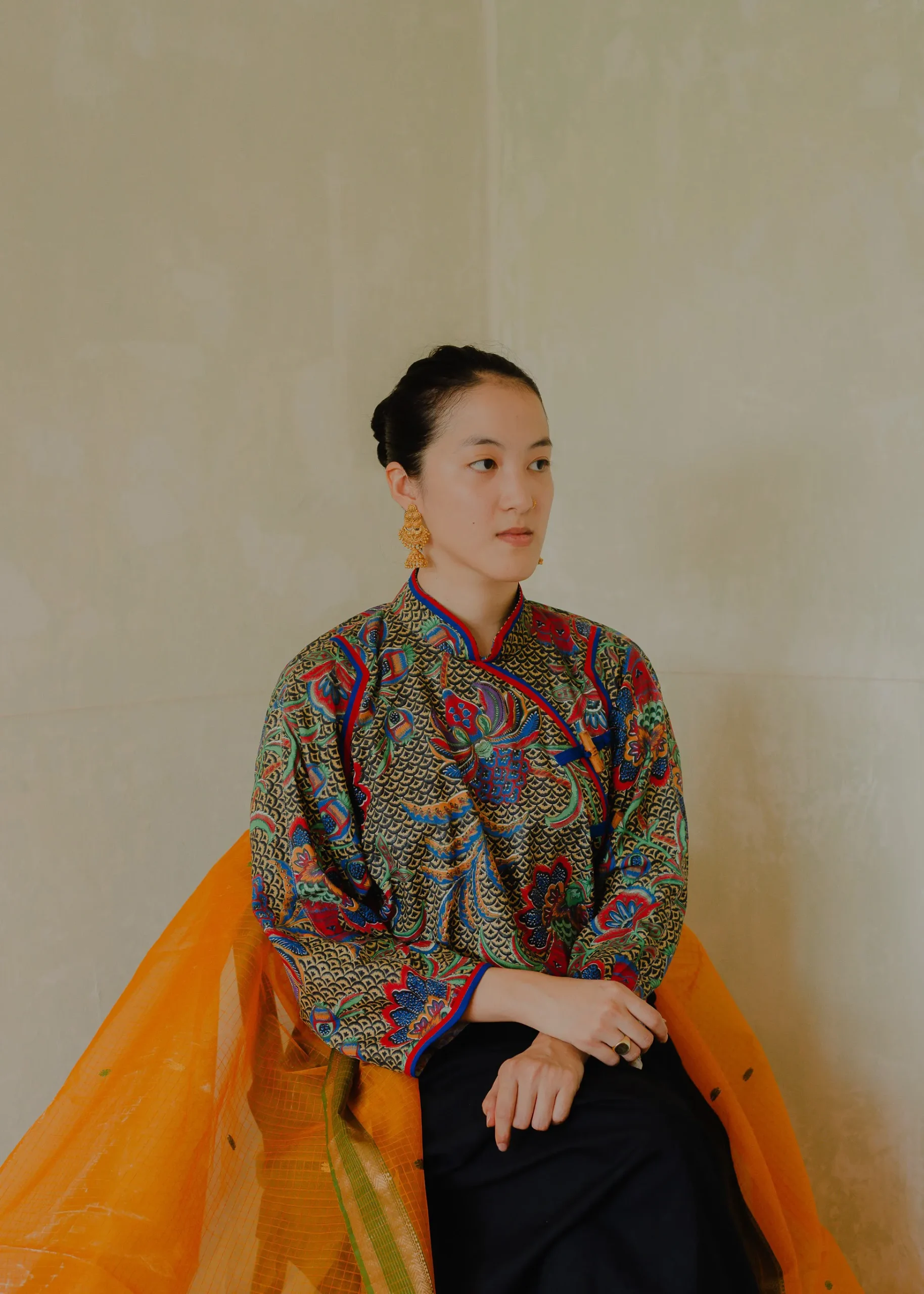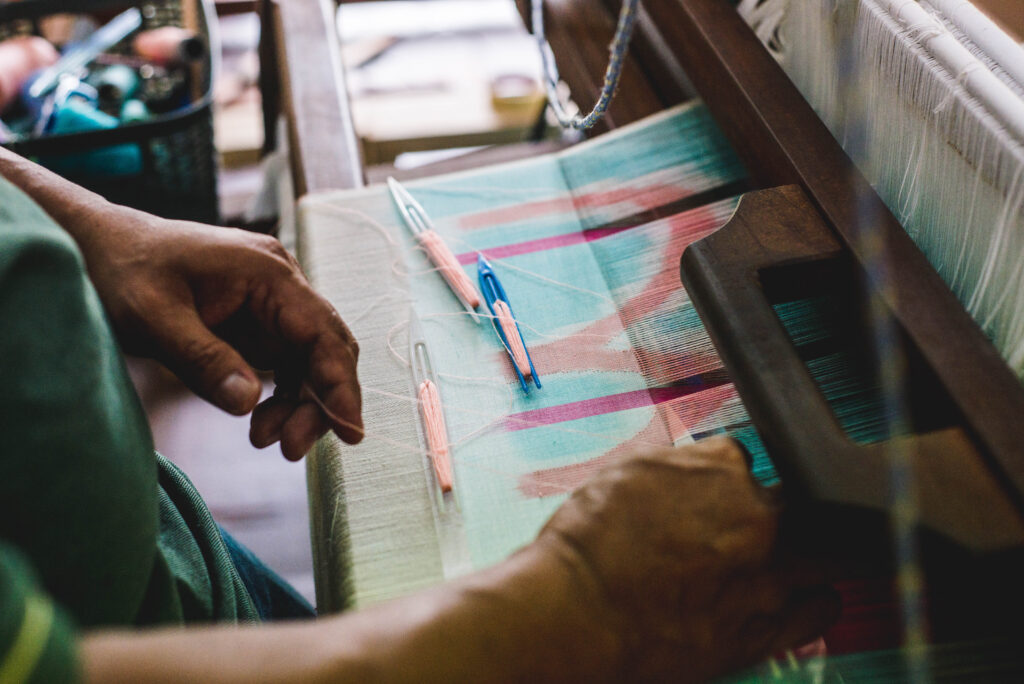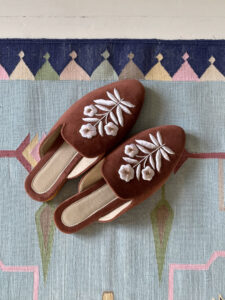In Conversation with: Shan Shan Lim
On Reciprocity and Reverence
Shan Shan Lim’s work moves between painting, textiles, and object—each shaped by her experiences across Malaysia, India, and London. A graduate of Central Saint Martins, she draws from family histories in architecture, design, and textile trade, translating them into forms that feel both personal and universal. In our conversation, she speaks about the balance between tradition and innovation, the importance of listening when working across cultures, and how collaboration begins with respect and curiosity.

Tell us about you and your lineages 💛 What context, whether cultural or geographical, historical or contemporary, or you designing from and within?
My lineage weaves through the textile shops of my grandparents in Malacca, the Himalayan foothills where I went to school and the artist studios of London where I deepened my understanding of the craft. My late mother, a Cantonese, was a designer and my father is an architect whose lineage traces back to the nomadic Hakka tribe in Southern China.
Creativity was a language spoken around me. The cultures I’ve lived within – Malaysia, India, the UK, Finland – each leave their trace on my work.
Shan Shan Lim
Tell us about your craft! What do you produce? Where?
I work across textiles, objects and space and produce everything from hand-embroidered velvet shoes to large-scale murals, woven tapestries and bedding collections. My studio was established in Kuala Lumpur, but my work travels. Some pieces begin in India, some are stitched in Finland, others are dreamt up in gardens and on flights. I see my practice as both rooted and nomadic.
How do you distinguish between design and craft in your work—or do you?
To me, design asks a question. Craft holds the answer in its hands. I don’t see them as separate. Design often begins with a sketch or even a whisper of an idea. Craft is how it takes shape: the hands, the tools, the rhythm. One imagines, the other remembers. When they’re in harmony, that’s when the work feels whole.
Do you believe craft should evolve with time? How do you balance tradition and innovation in your collaborations with artisans?
Absolutely. As something that is organic and alive, evolution is inherent to craft. But it must evolve with care. When I collaborate with artisans, I enter their world as a guest. I listen first, ask questions and then explore how we might walk a new path together. The most beautiful outcomes come from reimagining tradition with respect.

How do you navigate the balance between honoring traditional techniques and allowing space for the artisan’s own creative evolution?
It always starts with trust and mutual respect. When I worked with the weaving community in Pahang under Tunku Azizah Aminah, I brought my ideas to the table without trying to impose them. We worked together to translate contemporary sketches into something that could live on a 2-shaft floor loom. The weavers brought the kind of precision and rhythm that only comes from years of practice and I brought a vision shaped by my own research and training. The resulting pieces reminded me that honouring heritage doesn’t always mean replicating it.
What are your thoughts on cultural inspiration versus cultural appropriation? Do you believe designers should primarily draw inspiration from their own heritage—or is there space for exchange?
There’s absolutely space for exchange, but only when the source is acknowledged, respected and included. Cultural appropriation happens when that exchange is one-sided, when the origin story is erased or commodified. In Kalimantan, I was welcomed into a matriarchal weaving community and invited to learn about weaving from within. That experience showed me there are stories, rituals and social dynamics woven into every piece.
When working across cultures and geographies, how do you stay aware of the power dynamics at play?
By being conscious of context and moving with humility. When collaborating with communities, I’m always aware that I’m entering an existing tradition. They carry knowledge that’s been passed down through generations. It’s my responsibility to be transparent about my role, ensure fair credit and compensation, and design in a way that uplifts. Trust is earned slowly, and I try to honour that in every project.

How can we reimagine the role of the “designer” when working with traditional craft communities and ensure that craftsmen are not relegated to just “skilled laborers”?
By naming them as co-creators. By highlighting their artistry and their execution. In every project, I try to showcase the hands and stories behind the work. Designers should be facilitators of beauty.
To you, what makes a collaboration feel reciprocal rather than extractive?
Reciprocity feels like laughter over a cup of tea. It feels like both sides learning, sharing, shaping. It feels like leaving the project with both a product and a friendship. When both voices are present in the final piece, that’s when I know the exchange was true.
Have you ever had to unlearn or renegotiate your own assumptions around collaboration?
Many times. Especially early on. I used to think I needed to control every detail to ensure the work felt “mine.” But I’ve since learned that when I let go, the work grows in ways I could never have imagined.
How do you build trust when working with people from different lived experiences, languages, or social contexts?
Ans: Slowly and with time and honesty. Trust builds in the in-between moments: the shared meals, the mutual silences, the questions asked with care. I try to meet people as people first, before roles, deliverables or deadlines. That’s when the real work begins.

Can you share an example of a moment in your collaborative work that changed you—or your approach—unexpectedly?
In Jaipur, while developing my studio’s first in-house collection, I found myself fully immersed: sampling, solving, stitching together ideas with artisans across block printing, tailoring, and carpet weaving. One quiet but meaningful shift came through the creation of our first pair of hand-embroidered velvet shoes. Bringing them to life meant working closely with an embroiderer and a shoemaker, each adding their layer of skill. That process taught me that great collaboration builds quietly, stitch by stitch, until something new takes form.
What gives you hope about the future of collaborative, cross-cultural design?
The willingness I see in the next generation to listen, to slow down, to do better. There’s a movement toward transparency and depth. I’m hopeful because I see more and more designers and artist entering spaces with humility. More artisans are being recognised once again. I have hope that we’re gradually moving away from the exploitative world of fast fashion. But, of course, it will take time and persistence.
How can people find you and support your work?
Instagram: @shanshanlimstudios
Website: www.shanshanlimstudios.com